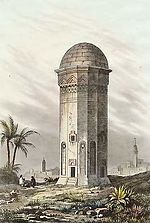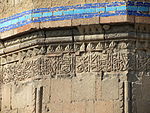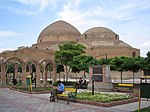Qara Qoyunlu
Qara Qoyunlu قره قویونلو | |||||||||||
|---|---|---|---|---|---|---|---|---|---|---|---|
| 1374–1468 | |||||||||||
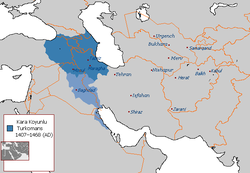 Qara Qoyunlu Turkomans, lighter blue shows their greatest extent in Iraq and Arabian East Coast for a small period of time | |||||||||||
| Status | Confederation | ||||||||||
| Capital | |||||||||||
| Common languages | |||||||||||
| Religion | Shia Islam (possibly) | ||||||||||
| Regierung | Monarchy | ||||||||||
| Ruler | |||||||||||
• 1375–1378 | Bayram Khwaja | ||||||||||
• 1467–1468 | Hasan 'Ali | ||||||||||
| Historical era | Middle Ages | ||||||||||
• Established | 1374 | ||||||||||
• Disestablished | 1468 | ||||||||||
| Currency | Akçe[6] Tanka[6] | ||||||||||
| |||||||||||
| History of Azerbaijan |
|---|
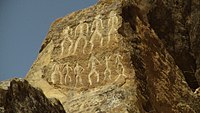 |
|
|
| History of Turkey |
|---|
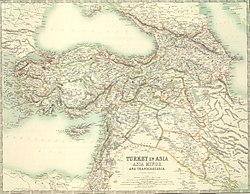 |
| Timeline |
|
|
| History of Iran |
|---|
 |
|
Timeline |
The Qara Qoyunlu or Kara Koyunlu (Persian: قره قویونلو, Azerbaijani: Qaraqoyunlular قاراقویونلولار), also known as the Black Sheep Turkomans, were a Persianate Muslim Turkoman[7][8][9] monarchy that ruled over the territory comprising present-day Azerbaijan, Georgia, Armenia, northwestern Iran, eastern Turkey, and northeastern Iraq from about 1374 to 1468.[10][11]
History
Origins
The ruling family descended from the Yıva tribe of the Oghuz Turks, specifically, the Baharlu tribe,[12] who by the 14th century possessed territories north of the Van Lake and Mosul, in Northern Iraq.[13] The tribes that comprised the Qara Qoyunlu besides Baharlu were Saadlu, Karamanlu, Alpaut, Dukharlu, Jagirlu, Hajilu, Agacheri.[14][page needed] According to Faruk Sümer, the Qara Qoyunlu tribe was undoubtedly a sub-tribe (oba) of the Oghuz, and Minorsky's claim that this sub-tribe belonged to the Yiwa is probably true.[15]
Duharlu Turkmens, a branch of Qara Qoyunlu first appeared in the Chronicle of Michael Panaretos. It is probable that the Duharlu tribe came to Anatolia from Central Asia during the Mongol invasion, as testified by the legendary tradition of Qara Qoyunlu.[16]

Rise
The Qara Qoyunlu Turkomans were initially vassals of the Jalairid Sultanate in Baghdad and Tabriz from about 1375, when the leader of their leading tribe ruled over Mosul. However, they rebelled against the Jalairids and secured their independence from the dynasty with the conquest of Tabriz by Qara Yusuf. In 1400, Timur defeated the Qara Qoyunlu, and Qara Yusuf fled to Egypt, seeking refuge with the Mamluk Sultanate. Qara Yusuf was welcomed by Sheikh Mahmud, the nâib of Damascus. Not long after, Jalairid Sultan Ahmed also came to Damascus. Not wanting to worsen relations with Amir Teymur, Nasir-ad-Din Faraj agreed to capture GaraYusif and Sultan Ahmed Jalairi, and hand them over to Teymur. Sultan Ahmed Jalayir and Kara Yusuf imprisoned on the order of Nasir-ad-Din Faraj. Together in prison, the two leaders renewed their friendship, making an agreement that Sultan Ahmed Jalayir should keep Baghdad while Qara Yusuf would have Azerbaijan. Ahmad also adopted his son Pirbudag. When Timur died in 1405 Nasir-ad-Din Faraj released them both. However, according to Faruk Sümer, they were released on the orders of rebellious wali of Damascus - Sheykh Mahmud.[17][18][19][20]
Qara Yusuf, having returned from exile in Egypt and went back to Anatolia. He forced Timur's governor in Van Izzaddin Shir to submit, while capturing Altamış, another viceroy set up by Timur and sending him to Barquq. He later moved on to the territories of Azerbaijan. He defeated the Timurid Abu Bakr at the Battle of Nakhchivan on 14 October 1406 and reoccupied Tabriz. Abu Bakr and his father Miran Shah tried to recapture Azerbaijan, but on 20 April 1408, Qara Yusuf inflicted a decisive defeat on them at the Battle of Sardrud in which Miran Shah was killed. In 1409 fall, Qara Yusuf entered Tabriz and sent a raiding party to Shirvan, especially Shaki, which was fruitless.[21]
In 1410, the Qara Qoyunlu captured Baghdad. The installation of a subsidiary Qara Qoyunlu line there hastened the downfall of the Jalairids they had once served. Despite internal fighting among Qara Yusuf's descendants after his death in 1420, The Qara Qoyunlu state collapsed after Qara Yusif. After the death of Qara Yusuf in December 1420, Shahrukh Mirza tried to take Azerbaijan from Qara Yusuf's son Qara Iskander, using the fact that none of his sons was accompanying his father. After the death of Qara Yusuf in December 1420, Shahrukh Mirza tried to take Azerbaijan from Qara Yusuf's son Qara Iskander, using the fact that none of his sons was accompanying his father. Despite defeating Iskander, twice in 1420–21 and 1429, only in the third expedition of Shahrukh Mirza in 1434–35 did the Timurids succeed, when he entrusted the government to Iskander's own brother, Jahan Shah (1436-1467) as his vassal. In 1436 he obtained the help of the Timurid ruler Shah Rukh to defeat QaraIskander and seize the throne for himself. He was also adopted by Goharshad Begum and crowned on 19 April 1438, along taking epithet "Muzaffar al-Din".[8][18] Due to the mistakes of his predecessor, Shahrukh Shah, the king of the Timurid state, was the first to convene a party in the palace. They brought the Timurids to the capital. But he went to war with his enemies, the Aq Qoyunlular. Jahanshah Haqiqi died in the battle of Mus. Qara Qoyunlu was almost destroyed. This time Hasanali Mirza came to power, but was killed by Uzun Hasan and the Qara Qoyunlu state collapsed.[22]
Decline
In 1410, Armenia fell under the control of the Qara Qoyunlu. The principal Armenian sources available in this period come from the historian Tovma Metsopetsi and several colophons to contemporary manuscripts.[23] According to Tovma, although the Qara Qoyunlu levied heavy taxes against the Armenians, the early years of their rule were relatively peaceful and some reconstruction of towns took place. This peaceful period was, however, shattered with the rise of Qara Iskander, who reportedly made Armenia a "desert" and subjected it to "devastation and plunder, to slaughter, and captivity".[24] Iskander's wars with and eventual defeat by the Timurids invited further destruction in Armenia, as many Armenians were taken captive and sold into slavery and the land was subjected to outright pillaging, forcing many of them to leave the region.[25] Iskander did attempt to reconcile with the Armenians by appointing an Armenian from a noble family, Rustum, as one of his advisers.
When the Timurids launched their final incursion into the region, they convinced Jihanshah, Iskander's brother, to turn on his brother. Jihanshah pursued a policy of persecution against the Armenians in Syunik and colophons to Armenian manuscripts record the sacking of the Tatev monastery by his forces.[25] But he, too, sought a rapprochement with the Armenians, allotting land to feudal lords, rebuilding churches, and approving the relocation of the seat of the Armenian Apostolic Church's Catholicos to Etchmiadzin Cathedral in 1441. For all this, Jihanshah continued to attack Armenian towns and take Armenian captives as the country saw further devastation in the final years of Jihanshah's failed struggles with the Aq Qoyunlu.[26]
Jahan Shah made peace with the Timurid Shahrukh Mirza; however, this soon fell apart. When Shahrukh Mirza died in 1447, the Qara Qoyunlu Turkomans annexed portions of Iraq and the eastern coast of the Arabian Peninsula as well as Timurid-controlled western Iran. Though much territory was gained during his rule, Jahān Shāh's reign was troubled by his rebellious sons and the almost autonomous rulers of Baghdad, whom he expelled in 1464. In 1466, Jahan Shah attempted to take Diyarbakır from the Aq Qoyunlu ("White Sheep Turkomans"), however, this was a catastrophic failure resulting in Jahān Shāh's death and the collapse of the Qara Qoyunlu Turkomans' control in the Middle East. By 1468, at their height under Uzun Hasan (1452–1478), Aq Qoyunlu defeated the Qara Qoyunlu and conquered Iraq, Azerbaijan, and western Iran.[27]
Religion
The argument that there was a clear-cut contrast between the Sunnism of the Āq Qoyunlū and the Shiʿism of the Qara Qoyunlū and the Ṣafawīya rests mainly on later Safavid sources and must be considered doubtful.[28]
— R. Quiring-Zoche, Encyclopædia Iranica
As to the religious affiliations of the Qara Qoyunlu, although some of the later members of the family had Shi'i-type names and there were occasional Shi'i coin legends, there seems no strong evidence for definite Shi'i sympathies among many Turkmen elements of the time.[29]
— C. E. Bosworth, The New Islamic Dynasties
During the Qara period, Shi'ism became widespread. Successful activities of Shaykh Junayd-i Safavi in Azerbaijan and Anatolia, and the Musha'sha'iyyah in Khuzestan are the most important pieces of evidence that Shi'ism was spread by the sword. It can be said, like Yar Ali (brother of Qara Yusuf) in the Qara Qoyunlu dynasty, there is a conscious love for Ali (caliph). However, the names of four caliphs are seen on the coins of Qara Yusuf, Isqandar and Jahan Shah. In addition to that, there is no record in the contemporary Aq Qoyunlu, Mamluk and Timurid sources that the Qara Qoyunlu rulers were inclined to Shi'ism.[1]
— Faruk Sümer, İslâm Ansiklopedisi
Governance
The Qara Qoyunlu state organization was based mainly on of its predecessors, Jalayirids, and the Ilkhanids. Qara Qoyunlu rulers used the title sultan since the enthronement of Pirbudag by Qara Yusuf. Sometimes the title bahadur appeared on the coinage. They also used the titles khan, khagan and padishah.[1]
Keeping with a Persianate culture,[30] the Qara Qoyunlu used the Persian language for diplomacy, poetry,[31] and as a court language.[2] Diplomatic letters to the Timurids and Ottomans were written in Persian, while the correspondance with the Mamluk sultans were in Arabic.[5] Official internal documents(farmān, suyūrghāl) were also written in Persian.[5]
As for the provincial organization, the provinces were governed by şehzade and beys, who had smaller divans in each of the provinces. The governance by military governors (beys) generally passed on from father to son. In the cities there were officials called darugha, that looked after financial and administrative affairs, and also had political powers. The şehzades and beys had their own soldiers which were called nökers, who were trained and salaried.[1]
Culture

Under Timur, the cultural entity of Iran was renewed by Persian literature, art and culture being patronized throughout the Timurid Empire.[32] Consequently, Qara Qoyunlu art was notably influenced by the Timurids.[33] Jahan Shah wrote his poetry in Azerbaijani and Persian, while the Kitab-i Diyarbakriyya, a history of the Qara Qoyunlu and Aq Qoyunlu, was written by Abu Bakr Tehrani in Persian.[34]
Although the Qara Qoyunlu rulers spent most of their lives in wars, they attached importance to science and art. Before the Qara Qoyunlus, many artists, poets and scholars worked in Tabriz, the center of the Jalairi and Timuri deputies. After defeating all his enemies, Qara Yusuf created conditions for artists, poets and scholars not to leave Tabriz, and they resumed their activities.[35]
Jahan Shah corresponded with one of the famous poets of the time, Abdurrahman Jami. Well-known scholars of his time taught in the Blue Mosque.[19]The famous Islamic scholar Jalaleddin al-Dawwani taught here and wrote the Risale-i Zawra and Shawakul al-Khurj.Sheikh Shujaaddin ibn Kamaladdin Kirmani dedicated his Gulshan-i Raz and Hadiqatul Maarif, which he completed in 1462, to Jahan Shah. The poet Mevlana Tusi served in the palace of Shahbudag, the son of Jahan Shah.[36]
Relations with the Safavid order
The ruler of Qara Qoyunlu, Jahan Shah, who was the most powerful dynasty of the time in Iran, informed Sheikh Junayd that he should leave Ardabil, otherwise he would burn the city down.[37] Upon this incident, Sheikh Junayd, Qara Qoyunlu's opponents, Aq Qoyunlu, sought asylum from Uzun Hasan, and later on, he married Uzun Hasan's sister "Hatice Begüm" and succeeded in turning this relationship into a kinship. After the death of Sheikh Junayd during a campaign against the Shirvanshahs, Sheikh Haydar, who succeeded him, got married to “Martha Alemşâh Begüm”[13], the daughter of Uzun Hasan from the Princess of the Trabzon Empire Theodora Despina Hatun. Ismâ'il, who was born from this marriage, later founded the Safavid State. The reason why Uzun Hasan was married to the "Princess of Trabzon Theodora Despina Hatun"[15]is Theodora Despina's father, IV. The reason was that Ioannis (the Trabzon emperor) needed the help of Uzun Hasan to protect the Trabzon Empire, which is his own country, from the Ottoman invasion.[17]
Architecture
See also
Notes
References
- ^ a b c d e Faruk Sümer (1988–2016). "KARAKOYUNLULAR Doğu Anadolu, Azerbaycan, İran ve Irak'ta hüküm süren Türkmen hânedanı (1351-1469).". TDV Encyclopedia of Islam (44+2 vols.) (in Turkish). Istanbul: Turkiye Diyanet Foundation, Centre for Islamic Studies.
- ^ a b Arjomand 2016, p. 11.
- ^ Faruk Sümer (1992). "Başlangıçtan Cihan-Şah'a Kadar". Kara Koyunlular (in Turkish). Vol. 1. Turkish Historical Society. p. 8. ISBN 9789751748478.
- ^ a b Minorsky 1954, p. 283.
- ^ a b c Bauden 2019, p. 423.
- ^ a b "Coins from the tribal federation of Qara Qoyunlu".
- ^ Philippe, Beaujard (2019). "Western Asia: Revival of the Persian Gulf". The Worlds of the Indian Ocean. Cambridge University Press. pp. 515–521. ISBN 9781108341219. "In a state of demographic stagnation or downturn, the region was an easy prey for nomadic Turkmen. The Turkmen, however, never managed to build strong states, owing to a lack of sedentary populations (Martinez-Gros 2009: 643). When Tamerlane died in 1405, the Jalāyerid sultan Ahmad, who had fled Iraq, came back to Baghdad. Five years later, he died in Tabriz (1410) in a battle led against the Turkmen Kara Koyunlu ("[Those of the] Black Sheep"), who took Baghdad in 1412."
- ^ a b "Kara Koyunlu". Encyclopaedia Britannica. "Kara Koyunlu, also spelled Qara Qoyunlu, Turkish Karakoyunlular, English Black Sheep, Turkmen tribal federation that ruled Azerbaijan, Armenia, and Iraq from about 1375 to 1468."
- ^ The Book of Dede Korkut (F.Sumer, A.Uysal, W.Walker ed.). University of Texas Press. 1972. p. Introduction. ISBN 0-292-70787-8. "Better known as Turkomans... the interim Ak-Koyunlu and Karakoyunlu dynasties..."
- ^ Hovanissian 2004, p. 4.
- ^ Encyclopædia Britannica. "Kara Koyunlu". Online Edition, 2007
- ^ Peter B. Golden (1992). An Introduction to the History of the Turkic Peoples. pp. 367–368.
- ^ a b Clifford Edmund Bosworth. The new Islamic dynasties: a chronological and genealogical manual. — Edinburgh University Press, 2004 — p. 273—274 — ISBN 0-7486-2137-7
- ^ Miklukho-Maklay, N. D. Shiism and its social face in Iran at the turn of the XV-XVI centuries "These tribes, which later became known as the Qizilbash tribes... created the states of Kara Koyunlu and Ak Koyunlu, which in the 15th century successively ruled Azerbaijan and most of Iran."
- ^ a b Sümer, F. (30 May 2021). "Ḳarā-Ḳoyunlu". In P. Bearman; Th. Bianquis; C.E. Bosworth; E. van Donzel; W.P. Heinrichs (eds.). Encyclopaedia of Islam (2nd ed.).
- ^ Rustam Shukurov (2016). The Byzantine Turks, 1204-1461. p. 289.
- ^ a b Muir, William (1986). Mameluke Or Slave Dynasty Of Egypt. Nabu Press. ISBN 978-1142162863.
- ^ a b "KARAKOYUNLULAR - TDV İslâm Ansiklopedisi". TDV İslam Ansiklopedisi (in Turkish). Retrieved 2022-04-07.
- ^ a b "Kara Koyunlu | History, Meaning, & Capital | Britannica". www.britannica.com. Retrieved 2022-04-07.
- ^ Shahmoradi, Seyyed; Moradian, Mostafa; Montazerolghaem, Asghar. "The Religion of the Kara Koyunlu Dynasty: An Analysis". Asian Culture and History. 5. doi:10.5539/ach.v5n2p95.
- ^ Grousset, René (1970). The Empire of the Steppes: A History of Central Asia. RUTGERS UNIV PR. ISBN 0-8135-1304-9.
- ^ Orly R. Rahimiyan. "Anjuman-i Markazī-yi Tashkīlat-i Ṣiyyonīt-i Irān". In Norman A. Stillman (ed.). Encyclopedia of Jews in the Islamic World. Brill. doi:10.1163/1878-9781_ejiw_sim_000228.
- ^ Kouymjian, Dickran (1997), "Armenia from the Fall of the Cilician Kingdom (1375) to the Forced Migration under Shah Abbas (1604)" in The Armenian People From Ancient to Modern Times, Volume II: Foreign Dominion to Statehood: The Fifteenth Century to the Twentieth Century, ed. Richard G. Hovannisian, New York: St. Martin's Press, p. 4. ISBN 1-4039-6422-X.
- ^ Kouymjian. "Armenia", p. 4.
- ^ a b Kouymjian. "Armenia", p. 5.
- ^ Kouymjian. "Armenia", pp. 6–7.
- ^ Stearns, Peter N.; Leonard, William (2001). The Encyclopedia of World History. Houghton Muffin Books. p. 122. ISBN 0-395-65237-5.
- ^ Quiring-Zoche 2009.
- ^ Bosworth 1996, p. 274.
- ^ Roy 2014, p. 38.
- ^ Minorsky 1954, p. 279.
- ^ Price 2005, p. 54.
- ^ Kadoi 2019, p. 83.
- ^ Lugal & Sümer 2002.
- ^ Sevay Okay Atılgan ,“Karakoyunlular’da Sanat Koruyuculuğu ve Şehzade Pir Budak Bahadır Han”, VII. Ortaçağ ve Türk Dönemi Kazı ve Sanat Tarihi Araştırmaları Sempozyumu Bildirileri (7-9 Nisan 2003, İstanbul), MSGSÜ Fen Edebiyat Fakültesi Sanat Tarihi Bölümü, İstanbul 2007, s. 25.
- ^ Vladimir Minorsky, “Karakoyunlu Cihan Şah ve Şiirleri”, Selçuklu Araştırmaları Dergisi II 1970, Ankara 1971, s. 165-166.
- ^ RM Savory, Safavids, Encyclopedia of Islam, 2. baskı.
Works cited
- Arjomand, Saïd Amir (2016). "Unity of the Persianate World under Turko-Mongolian Domination and Divergent Development of Imperial Autocracies in the Sixteenth Century". Journal of Persianate Studies. 9 (1): 11. doi:10.1163/18747167-12341292.
The disintegration of Timur's empire into a growing number of Timurid principalities ruled by his sons and grandsons allowed the remarkable rebound of the Ottomans and their westward conquest of Byzantium as well as the rise of rival Turko-Mongolian nomadic empires of the Aq Qoyunlu and Qara Qoyunlu in western Iran, Iraq, and eastern Anatolia. In all of these nomadic empires, however, Persian remained the official court language and the Persianate ideal of kingship prevailed.
- Bauden, Frédéric (2019). "Diplomatic Entanglements between Tabriz, Cairo, and Herat: a Reconstructed Qara Qoyunlu Letter Datable to 818/1415". In Bauden, Frédéric; Dekkiche, Malika (eds.). Mamluk Cairo, a Crossroads for Embassies:Studies on Diplomacy and Diplomatics. Brill.
- Bosworth, Clifford E. (1996). The New Islamic Dynasties. Columbia University Press.
- Kadoi, Yuka (2019). Persian Art: Image-making in Eurasia. Edinburgh University Press.
- Kouymjian, Dickran (2004). "Armenia from the fall of the Cilician Kingdom (1375) to the forced emigration under Shah Abbas". In Hovannisian, Richard G. (ed.). The Armenian People From Ancient to Modern Times, Volume I: The Dynastic Periods: From Antiquity to the Fourteenth Century. Palgrave Macmillan. ISBN 978-1-4039-6421-2.
- Lugal, Necati; Sümer, Faruk (2002). "KİTÂB-ı DİYARBEKRİYYE". İslâm Ansıklopedısı.
- Minorsky, V. (1954). "Jihān-Shāh Qara-Qoyunlu and His Poetry (Turkmenica, 9)". Bulletin of the School of Oriental and African Studies. 16 (2): 271–97. doi:10.1017/s0041977x00105981. JSTOR 609169.
- Price, Massoume (2005). Iran's Diverse Peoples: A Reference Sourcebook. ABC-CLIO.
- Quiring-Zoche, R. (2009-10-29). "AQ QOYUNLŪ". Encyclopedia Iranica.
- Quiring-Zoche, R. (1986). "Āq Qoyunlū". Encyclopædia Iranica, online edition, Vol. II, Fasc. 2. New York. pp. 163–168.
{{cite encyclopedia}}: CS1 maint: location missing publisher (link) - Roemer, H. R. (1986). "The Turkmen dynasties". In Lockhart, Laurence; Jackson, Peter (eds.). The Cambridge History of Iran, Volume 6: The Timurid and Safavid Periods. Cambridge: Cambridge University Press. ISBN 0-521-20094-6.
- Roy, Kaushik (2014). Military Transition in Early Modern Asia, 1400-1750. Bloomsbury.
Post-Mongol Persia and Iraq were ruled by two tribal confederations: Akkoyunlu (White Sheep) (1378–1507) and Qaraoyunlu (Black Sheep). They were Persianate Turkoman Confederations of Anatolia (Asia Minor) and Azerbaijan.
- Savory, R. M. (2009). "The Struggle for Supremacy in Persia after the death of Tīmūr". Der Islam. 40. De Gruyter: 35–65. doi:10.1515/islm.1964.40.1.35. S2CID 162340735.
Further reading
- Bosworth, Clifford. The New Islamic Dynasties, 1996.
- (in Armenian) Khachikyan, Levon. ԺԵ դարի հայերեն ձեռագրերի հիշատակարաններ, մաս 1 (Fifteenth Century Armenian Colophons, Part 1). Yerevan, 1955.
- Morby, John. The Oxford Dynasties of the World, 2002.
- Sanjian, Avedis K. Colophons of Armenian manuscripts, 1301-1480: A Source for Middle Eastern History, Selected, Translated, and Annotated by Avedis K. Sanjian. Cambridge: Harvard University Press, 1969.
- Shukurov, Rustam. The Byzantine Turks 1204-1461. Brill, 2016.
- Kara Koyunlu
- Empires and kingdoms of Iran
- Former countries in Western Asia
- Former countries in the Middle East
- Historical Turkic states
- Medieval history of Iran
- Medieval Iraq
- Medieval Azerbaijan
- Medieval Iranian Azerbaijan
- 15th century in Armenia
- Medieval Islam
- 14th century in Asia
- 15th century in Asia
- States and territories established in 1375
- States and territories disestablished in 1468
- 1375 establishments in Asia
- 1468 disestablishments in Asia
- Former monarchies of Western Asia
- 1370s in the Middle East

